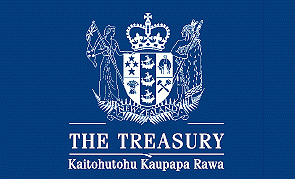
There is a risk unemployment rises and economic growth could be as low as 1.3% in the year to March 2011, compared to an official forecast of 2.2% GDP growth, according to Treasury's downside scenario included in its Half Year Economic and Fiscal Update. Annual March growth could then fall to 1.2% the following year, before rebounding 3.9% in the year to March 2013.
Treasury included a section on upside and downside risks facing the economy over the next five years in it's December update. The official forecast of 2.2% growth was also Treasury's upside scenario for GDP growth in the year to March, followed by growth of 3.4% in 2012 and 2.9% in 2013.
The full upside and downside scenarios are included below. First is Treasury's overview of the two, which surround its official forecasts for the next five years. However, Treasury notes the downside scenario does not include any fiscal policy responses that would be necessary if events evolved in a manner similar to the downside scenario.
From Treasury's Half Year Economic and Fiscal Update:
Risks and scenarios
There are always uncertainties and risks associated with forecasts. These can be sourced from both the international economy and domestic developments.
Global developments present both upside and downside risks…
Although most economies are now growing again after the GFC, there is considerable uncertainty about the pace and durability of the recovery in many developed economies.
One source of downside risk relates to sovereign and banking system funding problems in some European economies and associated risks of contagion. An intensification and broadening of these problems to other countries would likely have significant negative impacts on activity levels, official interest rates and capital flows, particularly in Europe, with spill-overs to the rest of the world.
Another uncertainty relates to the response of the private sector to the ending of fiscal stimulus and in some economies the switch to fiscal consolidation. Consolidation will act to dampen domestic demand in the shorter term. As a result, the pace of growth will depend on the degree of offset coming from any crowding-in of private sector investment or higher net exports.
Other risks include the pace of recovery in the US, where there is continuing weakness in the labour and housing markets, and the extent of global imbalances which could lead to an increase in trade and capital barriers. These would impair world growth and, depending on the nature of the barriers, could adversely affect New Zealand export volumes.
Risks in China and emerging Asia are tilted to higher growth as these economies continue their economic development. Although China is currently taking steps to constrain credit growth, with some consequent short-term risks to growth, ongoing infrastructure investment and the scope for private spending to expand could see higher average growth over the next five years and further boost demand for minerals and soft commodities. It is also possible that the US and European economies could grow more quickly than expected if the current headwinds to growth dissipate faster than currently expected.
Economic strength in developing countries has helped support global commodity prices and boosted New Zealand’s terms of trade, which are expected to remain elevated over the next five years. Past experience, however, indicates that negative shocks to commodity prices cannot be ruled out. Disappointing growth from emerging markets would be one factor that could result in lower demand and commodity prices than in the main forecasts.
…while the impact of atypical events and the behaviour of households present domestic risks
In the domestic economy, there is uncertainty about the degree to which rebuilding from the Canterbury earthquake will boost growth, and over what period. Since the forecasts were finalised, there have been a number of adverse developments. These are the discovery of a kiwifruit disease, the disaster at Pike River coal mine and the dry conditions developing in parts of the country as a result of the La Niña weather pattern. Risks of this kind will always exist in an economy with a large natural resource base, with drought effects having potentially significant adverse impacts on output and exports. Record temperatures during November mean that the risk that drought conditions will adversely impact on economic activity is particularly high.
New Zealand households have taken initial moves towards strengthening their financial position and are much more cautious about taking on debt, but it is not clear how sustained their restraint will be. Greater restraint will lead to lower growth in the short term, but possibly more sustainable growth in the long term; less restraint would bring higher growth in the near term, but risk a sharper deleveraging and rebalancing later.
Developments in the housing market will influence household behaviour, with any additional housing market weakness likely to dampen household spending levels.
Two scenarios have been developed from these risks to illustrate the uncertainty associated with the current economic outlook. The scenarios are constructed by applying relevant shocks and alternative judgements to the New Zealand Treasury Model (NZTM).
They should be treated as providing a high-level representation of how the economy could differ from the main forecasts. The focus is on key economic variables, rather than the larger suite produced as part of the main forecasts.
As a result, significantly different outcomes are possible
While the main forecast represents our view of the most likely path the economy will take, the scenarios illustrate that a large range of different outcomes is possible. The upside scenario assumes a stronger outlook for China and emerging Asia flows through to the economy in the form of higher prices for commodity exports. The downside scenario represents a more severe event with larger economic and fiscal implications, but with a lower probability. In this scenario, global growth falters and New Zealand’s terms of trade are adversely affected. The scenarios are extended into the projection period in the same way as the main forecasts were in the preceding section, illustrating the considerable range in fiscal outcomes that could occur.
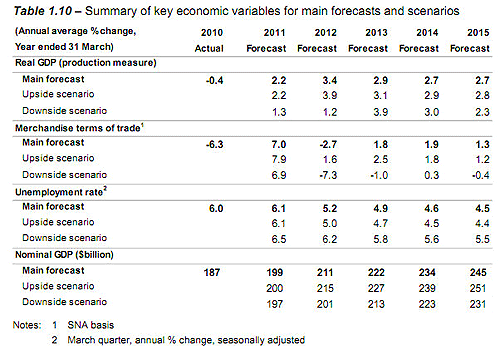
Upside scenario
Stronger demand for commodities lifts the terms of trade above the main track…
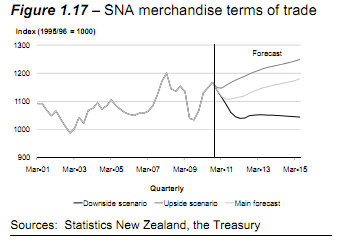
New Zealand is a key supplier of soft commodities to the global economy, particularly dairy products and meat. Limited global resources and long lags in production mean that changing demand manifests itself in price swings in the short term, having a significant impact on the terms of trade and the overall economy.
The main forecasts assume that the terms of trade ease off in the short run but remain elevated over the medium term. In the upside scenario, it is assumed that stronger demand from key trading partners (particularly China and Australia) results in higher commodity prices and a continuation of the upward trend seen in the terms of trade over the past decade (Figure 1.17).
…and benefits flow through the rest of the economy
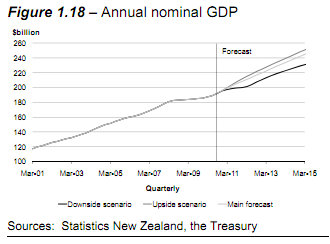
A higher terms of trade places upward pressure on the exchange rate, which, coupled with stronger earnings, leads to increased domestic demand. Private consumption growth averages 3.1%, compared with 2.4% in the main forecasts, and residential investment also lifts, driving GST revenue higher. In line with recent trends, some of the income surprise is saved, lifting the household saving rate above that in the main forecasts over the medium term. Stronger export values relative to imports drive a lower overall profile for the current account deficit.
More robust demand creates some inflation pressure, but higher potential output owing to stronger investment, combined with a more elevated exchange rate, means the overall impact on consumer prices is relatively small, allowing official interest rates to remain broadly similar to those expected in the main forecasts.
…driving higher tax revenues and a more positive fiscal position
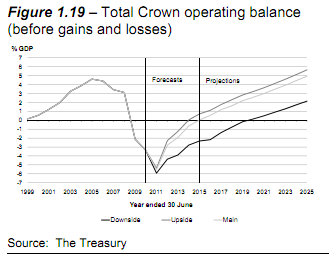
The stronger economic outlook in this scenario lifts nominal GDP $4.2 billion (2%) higher in the March 2012 year and a cumulative $23 billion higher than the main forecasts over the 2011 to 2015 June years. Such a scenario would boost demand for labour and wages, flowing through to higher PAYE tax revenue which, together with higher corporate tax and GST, results in overall tax revenue being a cumulative $6.6 billion higher than in the main forecasts.
With expenses broadly similar to the main forecasts, higher tax revenues mean the overall fiscal outlook is stronger than envisaged in the main forecasts. The operating balance (before gains and losses) breaks even in the June 2014 year, one year earlier than in the main projections. Net debt is projected to fall below 20% of nominal GDP in the June 2020 year, two years earlier than in the main projections.
Core Crown operating surpluses (before gains and losses) are projected to be of sufficient size to trigger the resumption of contributions to the NZSF by the June 2018 year – one year earlier than in the main projections.
Downside scenario
Global growth falters and financial conditions tighten, leading to lower export demand…
The downside scenario centres on sovereign debt issues in Europe intensifying and causing financial market disruption globally. As a result, global growth prospects falter. The channels through which such an event impacts on the New Zealand economy are primarily export demand, access to credit, confidence and wealth.
In this scenario, export demand is negatively affected, with lower commodity prices reflected in a much lower terms of trade, despite weakness in prices for some of the goods New Zealand imports (Figure 1.17 above). Although we would expect to see a significant decline in the exchange rate that would help offset lower export prices, the extent of the fall in demand means that overall export values are likely to be lower than in the main forecasts.
With financial markets experiencing renewed dislocation and risk aversion rising, capital-importing countries such as New Zealand could expect to face higher global funding costs. While official interest rates are likely to be lowered in such an event to limit the impact on retail interest rates, banks’ access to funding could be more limited. The net result would be a more restricted supply of credit, at a higher price, to businesses and households. With confidence levels hit by the global situation, demand for credit also falls, resulting in weaker business and residential investment growth.
…and weaker private consumption
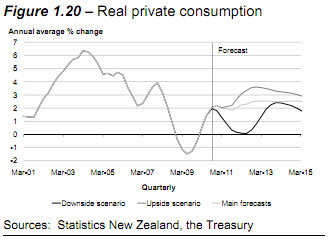
House prices could be expected to fall further, reflecting a lack of confidence and credit, driving household wealth lower. Lower wealth, together with a weaker labour market, results in a significantly lower profile for real private consumption (Figure 1.20)
…driving real growth lower than in the main forecasts…
With business investment, residential investment and private consumption all weaker than in the main forecasts, the overall profile for real GDP is markedly lower than in the main forecasts.
The lower terms of trade, coupled with softer domestic prices, reflecting the weaker domestic economy, results in nominal GDP in the five years to June 2015 being around a cumulative $50 billion lower than in the main forecasts, with tax revenues expected to be nearly a cumulative $18 billion lower over the same period.
…and weakening the fiscal outlook
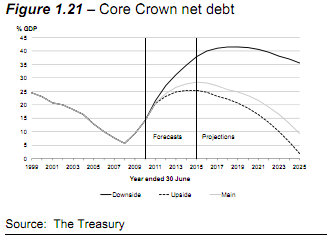
The total Crown operating balance (before gains and losses) would still be in deficit by about 2½% of GDP in the June 2015 year, while core Crown net debt would have risen to nearly 40%. Across the 10 years of post-forecast projections there is little recovery in the nominal GDP track, relative to that arising from the main forecast. As a consequence, the tax revenue gap of the next five years is maintained, which, in turn, flows through to much-lower operating balances. With surpluses taking longer to achieve, and being smaller when they do occur, the net debt track does not begin to reduce, as a percentage of GDP, until the end of this decade. The long-term target of net debt at 20% of GDP is not attained, with the ratio falling to about 35% by the mid-2020s.
It is important to note that the fiscal scenarios do not include a fiscal policy response which would be necessary if events were to evolve in a similar manner to that outlined in the downside scenario.
5 Comments
Always with the "rebound"...this cat is taking a pounding...it's as well it's dead.
I wonder if Treasury pointy heads were divided and sent to two separate rooms where one lot were asked to tell the truth about the future and the other lot to make it up as they went along!
Now which group was which
Think it's best to go with the ones who were as honest as the recession is long!
Sorry Basel I was busy counting gold coins...yes I agree with you...they refused to consider Black Swan events...on the premise that things not thought of can never happen....works every time...until
The other side of the coin is also worth a gork....White Kiwi! massive oil and gas discover off the Beehive in wgtn harbour....gargantuan gold discover on the Chathams....breakthrough medical find in Purple Witch's Hats....the Labour Party emigrating to Aus to be with Jewleya....
oh that last Swan would be soooooo good.
Talking about good bad and ugly.....another 'Indian' is being scalped in the land of the not so free...
"LOS ANGELES — US prosecutors have charged a California woman with insider trading for selling secret information for over 200,000 dollars, the latest arrest in a widening probe, officials said."
Meanwhile none of the bankers who rorted billions, have been charged...the best was the boss of Countrywide who escaped with a fabulous amount of other people's money.

We welcome your comments below. If you are not already registered, please register to comment.
Remember we welcome robust, respectful and insightful debate. We don't welcome abusive or defamatory comments and will de-register those repeatedly making such comments. Our current comment policy is here.